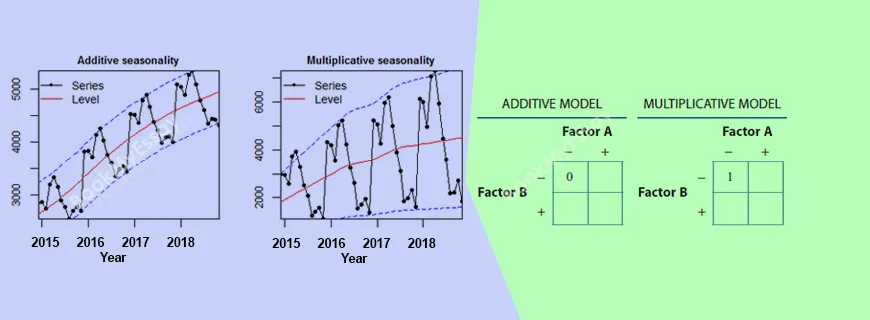Online Professional Additive and Multiplicative Models Assignment Help
Definition of Additive Model and Multiplicative
Addictive method is considered as a data model that has effects of individual factors that can be differentiated which can be added together for data modelling. This can feature in multiple Minitab Commands:
- An additive model is remarked as decomposition procedures which is inclusive of Winters’ method.
- Such model is considered as optional which has two-way ANOVA procedures. This can be selected as option to overlook interaction term which need to be extracted from the model.
Multiplicative Model is another model which presumes the data increase along with the seasonal pattern. Many of the time series plots display this pattern. In such model, all the trend and seasonal components get multiplied which can be added to error component. If you are a college student and seeking best Additive and Multiplicative Models assignment help? Then feel free to contact BookMyEssay experts and enjoy the best Australian writers service.
Discuss the Core Difference Between Additive Model or a Multiplicative Model
- One must select multiplicative model as and when the magnitude of seasonal data pattern relies on data magnitude. In other words, seasonal pattern magnitude expands the data value increases, and when decreases the data declines.
- When Additive Model is chosen, the magnitude of seasonal data pattern does not rely on data magnitude. This indicates that when the magnitude of seasonal pattern does not alter as and when the series goes up or down.
- In a scenario, when data pattern data is not that tricky, the user have a tough time selecting between additive and multiplicative procedures. The user can then attempt both the models and select one which has much smaller accuracy measures.
In Context of Time Series Data
Additive and Multiplicative Models assignment writing help discuss a major aspect of analysing the Time Series, especially when the user has to keep their hands on the web analytics. In order to analyse time series, this helps in understanding and holding the interaction between overall seasonality in activity which is the underlying trend. One need to carry out interactions between seasonality and trend which are classified into additive or multiplicative.
Additive or Multiplicative Modelling for Time Series
For users it is important to outline the difference between multiplicative / additive time series. For this, it is essential to review 3 major components attached to the time series. This includes assessment of:
- Pattern in which things are changing on the whole
- Seasonality as to how things alter within a specific time period that is a year, week, month, or a day
- Mapping of an error/ residual /unbalanced activity which cannot be explained by trend or the set seasonal value
All above listed components and their interactive trends outline the difference between Multiplicative / Additive Time Series. Talking about the multiplicative time series, all the components need to be multiplies together to frame a thorough time series. In case the user has an increasing trend, the breadth of seasonal activity expands, leaving everything pretty exaggerated. On the other hand, additive time series has components that can be added together to frame a Time Series. In case a user views an increasing trend, he/she has to view the same throughout the given time series. It is also referred to as indexed time series that has absolute value which tends to grow keeping the changes as relative.
Decomposing the data is yet another method to determine if time series is additive or multiplicative in nature. For this, the time series must be split into a number of components. The components explained in detail in the Additive and Multiplicative Models homework and assignment help that include:
- The trend – This is regarded as the first component which can be done in numerous ways. Keeping this in the simplest manner, one must involve calculating a median or moving average.
- The seasonality – This refers to the changing cyclical patterns which happen to appear in the time series as soon as the data has its trend eliminated.
The above ways can differ as per the kid of time series a person is working on. So, both Additive and Multiplicative Models are employed to calculate the residual appearing in both the situations to see which one has more suitability.
Why Choose BookMyEssay for Additive and Multiplicative Models Assignment Writing?
BookMyEssay is prestigious site that is engaged in offering top rated essay writing, dissertation thesis help, and coursework writing service. This site invites students from all over the world to avail this help service at a nominal price without taking a toss on the quality. Each assignment delivered is assured to be free from plagiarism, spelling and grammatical errors and is bound to impress the reviewers. The Additive and Multiplicative Models assignment help and writing service is backed with 100% satisfaction guarantee so that students reap complete benefit form the money invested. Free reworks are also provisioned for students.


